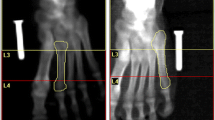Abstract
Objective
To investigate the reliability of a simple, efficient technique for measuring bone mineral density (BMD) in the metatarsals using dual-energy X-ray absorptiometry (DXA).
Materials and methods
BMD of the right foot of 32 trained male distance runners was measured using a DXA scanner with the foot in the plantar position. Separate regions of interest (ROI) were used to assess the BMD of each metatarsal shaft (1st–5th) for each participant. ROI analysis was repeated by the same investigator to determine within-scan intra-rater reliability and by a different investigator to determine within-scan inter-rater reliability. Repeat DXA scans were undertaken for ten participants to assess between-scan intra-rater reliability.
Results
Assessment of BMD was consistently most reliable for the first metatarsal across all domains of reliability assessed (intra-class correlation coefficient [ICC] ≥0.97; coefficient of variation [CV] ≤1.5 %; limits of agreement [LOA] ≤4.2 %). Reasonable levels of intra-rater reliability were also achieved for the second and fifth metatarsals (ICC ≥0.90; CV ≤4.2 %; LOA ≤11.9 %). Poorer levels of reliability were demonstrated for the third (ICC ≥0.64; CV ≤8.2 %; LOA ≤23.6 %) and fourth metatarsals (ICC ≥0.67; CV ≤9.6 %; LOA ≤27.5 %). BMD was greatest in the first and second metatarsals (P < 0.01).
Conclusion
Reliable measurements of BMD were achieved for the first, second and fifth metatarsals.


Similar content being viewed by others
References
Chowchuen P, Resnick D. Stress fractures of the metatarsal heads. Skeletal Radiol. 1998;27:22–5.
Datir AP, Saini A, Connell A, Saifuddin A. Stress-related bone injuries with emphasis on MRI. Clin Radiol. 2007;62:828–36.
Gross TS, Bunch RP. A mechanical model of metatarsal stress fracture during distance running. Am J Sports Med. 1989;17:669–74.
Bennell KL, Malcolm SA, Thomas SA, et al. Risk factors for stress fracture in track and field athletes: a 12-month prospective study. Am J Sports Med. 1996;24:810–8.
Bennell KL, Malcolm SA, Thomas SA, Wark JD, Brukner PD. The incidence and distribution of stress fractures in competitive track and field athletes. Am J Sports Med. 1996;24:211–7.
Griffin NL, Richmond BG. Cross-sectional geometry of the human forefoot. Bone. 2005;37:253–60.
Kelsey JL, Bachrach LK, Procter-Gray E, et al. Risk factors for stress fracture among young female cross-country runners. Med Sci Sports Exerc. 2007;39:1457–63.
Sindel M, Keles-Coskun N, Melikoglu MA, et al. Bone mineral density of the metatarsal bones and the first ray in male sportsmen. Int J Exp Clin Anat. 2010;4:39–44.
Peter Z, Bousson V, Bergot C, Peyrin F. A constrained region growing approach based on watershed for the segmentation of low contrast structures in bone micro-CT images. Pattern Recogn. 2008;41:2358–68.
Hopkins WG. A new view of statistics. Internet Society for Sport Science 2000. http://www.sportsci.org/resource/stats/ Accessed 21 Oct 2014.
Bland JM, Altman DG. Statistical methods for assessing agreement between two methods of clinical measurement. Int J Nurs Stud. 2010;47:931–6.
Bayar A, Sarikaya S, Keser S, Ozdolap S, Tuncay I, Ege A. Regional bone density changes in anterior cruciate ligament deficient knees: a DEXA study. Knee. 2008;15:373–7.
Sievanen H, Oja P, Vuori I. Precision of dual-energy X-ray absorptiometry in determining bone mineral density and content of various skeletal sites. J Nucl Med. 1992;33:1137–42.
Sievanen H, Koskue V, Rauhio A, Kannus P, Heinonen A, Vuori I. Peripheral quantitative computed tomography in human long bones: evaluation of in vitro and in vivo precision. J Bone Miner Res. 1998;13:871–82.
Conflict of interest
The authors declare that they have no conflicts of interest.
Author information
Authors and Affiliations
Corresponding author
Rights and permissions
About this article
Cite this article
Fuller, J.T., Archer, J., Buckley, J.D. et al. The reliability of dual-energy X-ray absorptiometry measurements of bone mineral density in the metatarsals. Skeletal Radiol 45, 135–140 (2016). https://doi.org/10.1007/s00256-015-2227-0
Received:
Revised:
Accepted:
Published:
Issue Date:
DOI: https://doi.org/10.1007/s00256-015-2227-0




